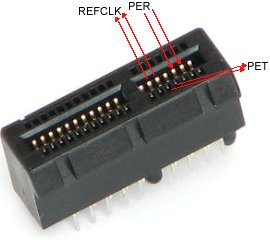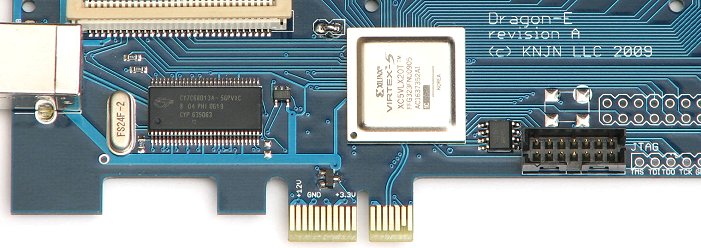在FPGA4FUN上看到一篇介绍PCI-E的帖子,简单易懂,适合入门,特地搬过来
原文地址:http://www.fpga4fun.com/PCI-Express.html
前言:
As PCI Express becomes common place in high-end FPGAs, let's see how easy FPGA vendors made the technology available.
由于PCI-E在高端FPGA中变得越来越常见,我们来看看FPGA厂商们是怎样让它很容易的为我们所用的
In particular, we look more closely at Xilinx's PCI Express solution.
以赛灵思为例
全文分为六个部分,第一部分:
PCI Express - Connector
PCI Express comes commonly in two sizes: 1-lane and 16-lanes, with 1-lane used for regular boards and 16-lanes used for graphic cards.
PCI-E通常分为两种规模:一路的用在常规板子上,16路的用在图形卡上
The connector
The 1-lane connector has 36 contacts, arranged in two rows of 18 contacts.
Here's a top view.

Of the 36 contacts, only 6 are useful to the transport of data, the rest are power pins and other auxiliary signals. The 6 functional contacts are used in 3 pairs:
一路的连接器分成有36个引脚,分成两行,每行18个。在这36个引脚中,只有6个是用作数据传输的,其余的都是电源或者辅助信号。这6个引脚分成3对
- A clock pair called REFCLK.
- A receive pair called PER.
- A transmit pair called PET.

The pairs are often referred as "differential pairs" because each signal from a pair carries the same signal but with one inverted from the other. The reason for using differential pairs is mainly reliability of transmission and will be discussed in more details later.
时钟、数据接收和发送这三对信号线使用差分传输
In PCI Express generation 1 (or simply "Gen1"), the PET and PER pairs have data transmitted at a speed of 2.5Gbps. Gen2 doubles that.
第一代PCI-E数据传输速度为2.5Gbps,第二代为5Gbps。
Looking at the Dragon-E board, we can recognize the PET pair below the FPGA.

To work correctly, the lines in a differential pair need to be electrically coupled and have no impedance discontinuities, which in practice means something like "stay close together" and "no sharp angles". That's the reason for the Dragon-E's PET pair serpentine shape. The other side of the board shows the two other serpentine pairs REFCLK and PER.
为了能正常工作,差分信号线必须要电耦合和阻抗连续,这有点像“靠近一点”和“没有锐角”,这也就是为什么Dragon-E上的差分线看着像蛇形。
PCI Express x16
To allows for more speed, multiple lanes can be used. The REFCLK pair doesn't need to be duplicated, so for example, PCI Express with 2 lanes uses 5 pairs (1 REFCLK + 2 PET + 2 PER).
Graphic boards often use 16 lanes connectors in what is commonly called PCI Express x16.
为了实现更高的速度,我们可以使用通道复用。时钟线不需要复用,举个例子,两通道的PCI-E使用5对线(1路时钟+2路数据发送+2路数据接收),图形卡经常使用16通道连接器。
点名说一下 verilog-IT大道,转了我多少篇博客,也不标明出处。这篇文章我刚发出去就被转载了,你们的爬虫很厉害啊!